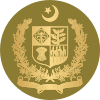Havildar
A havildar or havaldar (Hindustani: हविलदार (Devanagari) حوِلدار (Perso-Arabic)) is a rank in the Indian and Pakistani armies, equivalent to a sergeant. It is not used in cavalry units, where the equivalent is daffadar. Like a British sergeant, a havildar wears three rank chevrons.[1]


Historically, a havildar was a senior commander, being in charge of a fort during the times of the Mughal Empire and later Maratha Empire. It was used as the equivalent of a sergeant in the British Raj, which has led to its current usage.
Havildar is a Persian word in origin and means "person in charge", or more loosely "chief", from the Arabic حواله ("charge", "responsibility") and the Persian دار (dâr, "holder").
Appointments in the Indian Army
Havildars could be further appointed to positions of higher authority. However, these ranks are currently not in active use.




Historically, the two senior-most havildars of a company became the CQMH and the CHM. However, these were just appointments and the CO could promote or demote any of these ranks at his discretion.[2]
The appointments of company quartermaster havildar and company havildar major also existed in the British Indian Army.[2]
These appointments still technically exist in the Indian Army.[3] However, they have fallen out of use and havildars are now promoted directly to junior commissioned officer ranks, by whom the duties of these historical appointments are now carried out.[1][2][4][5][6]
Appointments in the Pakistan Army
Havildar is the third highest enlisted or Non Commissioned Officer military rank in the Pakistan Army. Usually a Havaildar have three Naiks under him and each Naik have ten soldiers under him, making it a military unit of thirty four personnel. Lance Naik, Naik (Lance Havildars) and Havildars are higher grades with pay increases awarded to soldiers and Naiks respectively with a good record and performance by Company Commander and Battalion Commander respectively. Every Havildar might have a Naik (Lance Havildar) out of three Naiks under him and each Naik might have at least one Lance Naik out of ten soldiers under him.
Appointments for Havildars in Pakistan Army are:
![]()




In a Company there are seven to eight Havildars. Out of these Havildars, a senior Havildar might act as a Company Quartermaster Havildar while a more senior Havildar might be appointed as Company Havildar Major responsible for the discipline, morale and training of all the soldiers within his Company.
In a Battalion there are usually twenty four to twenty eight or twenty nine Havildars. A senior Havildar might be appointed as Battalion Quartermaster Havildar and the most senior Havildar of the Battalion or the most qualified Havildar might be appointed as its Battalion Havaildar Major having power over all the soldiers in his Battalion regardless of his actual responsibility of thirty four strong military unit.
All of these appointments have different insignia and may vary from unit to unit.
References
- "Indian army ranks". Ranks of the army. Archived from the original on 2 February 2014. Retrieved 19 January 2014.
- "India Military Ranks". Ravi Rikhye. 28 April 2002. Archived from the original on 28 July 2013. Retrieved 19 January 2014.
- "Archived copy". Archived from the original on 9 November 2014. Retrieved 4 December 2015.CS1 maint: archived copy as title (link)
- "Info" (PDF). aftkolkata.nic.in. Retrieved 18 July 2020.
- M K Sunil Kumar (16 May 2012) [21 November 2010]. "Rules of the Raj hindering havildars' promotion". The New Indian Express. Retrieved 4 December 2014.
- "Data" (PDF). www.indianarmy.gov.in. Retrieved 18 July 2020.